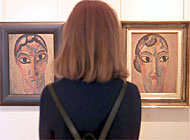
Jawlensky’s “Swiss” works on display at Lausanne’s Hermitage

The Russian-born German expressionist, Alexei von Jawlensky, is the subject of a new exhibition at Lausanne's Hermitage Foundation. The 100 paintings on show concentrate on the seven productive years the influential artist spent in Switzerland.
Most art critics agree that the time Jawlensky spent in Switzerland played a vital role in shaping his art, yet this is the first major exhibition devoted to this period.
The artist fled to Switzerland at the outbreak of the First World War. Along with his friend Wassily Kandinsky, he had become one of the leading figures of Munich’s avant-garde art movement. But after 1914, the city was not a safe place for a Russian.
Almost by accident, Jawlensky found himself in a friend’s small house in the tiny medieval village of St Prex, on the banks of Lake Geneva. He was intending to stay only a short time, but remained in Switzerland for several years.
“When he came to Switzerland, it was an abrupt change. He had been one of the leading figures in the fauvist expressionist movement in Munich and now he was completely isolated,” explained the exhibition’s curator, Giselle Eberhard.
Nevertheless, the quiet life in St Prex, with little money and using cheaper materials, turned out to be one of the most influential periods in Jawlensky’s life: “He became introspective and began to simplify his art,” Eberhard told swissinfo.
One of the most significant developments in his work at this time was his decision to paint series of near identical pictures, where the same scene would be constantly revisited and modified.
Jawlensky did five of these major series in his career. The first, which reflects a calmer more reflective artist, was the Variations series, based on the view across Lake Geneva from his window in St Prex.
He worked on that same view for several years, producing more than 380 paintings. Over time, he moved further and further away from objective reality, the trees, path, lake and mountains becoming splashes of colour.
“By the end it was less to do with the view than a reflection of his feelings and inner state,” Eberhard says.
The exhibition at the Hermitage also contains many paintings from three further series painted in Switzerland – Mystical Heads, the Saviour’s Faces and Abstract Heads. These abstracts were completed after Jawlensky left St Prex and went to live in Zurich and then Ascona.
These constructivist paintings have been scattered in collections all over Europe and it is a rare opportunity to see several of them in one place at the same time. The oval and U-shaped faces have a haunting, mystical intensity.
“They have a kind of iconic value,” Eberhard said. “He was very aware of his own Russian artistic culture. These faces are not portraits, as we would consider them in Western Europe. They are icons. It was almost a religious process for him.”
Among the 100 or so paintings in the exhibition are a number by artists Jawlensky met and worked with during his time in Switzerland. These include Paul Klee, Ferdinand Hodler, Jean Arp, Marcel Janco and Hans Richter.
“Jawlensky had a strong artistic personality, so he was not really influenced by the artists he met. They were travelling on parallel paths to abstraction,” Eberhard explains.
In 1917, Jawlensky decided to leave St Prex for Zurich, which had earned itself a reputation for being a hotbed of the dadaist movement, thanks to the Cabaret Voltaire. While not a dadaist himself, Jawlensky felt liberated by being once again in a thriving artistic community.
A year later, however, Jawlensky was forced to move on again. Having caught Spanish flu, he was advised by his doctors to live somewhere warmer. He opted for another pretty Swiss lakeside town, Ascona, on the banks of Lake Maggiore.
The Russian, though, seems to have had very little professional contact with the Monte Verità artists’ community that was active in Ascona at the time.
by Roy Probert

In compliance with the JTI standards
More: SWI swissinfo.ch certified by the Journalism Trust Initiative




























You can find an overview of ongoing debates with our journalists here . Please join us!
If you want to start a conversation about a topic raised in this article or want to report factual errors, email us at english@swissinfo.ch.